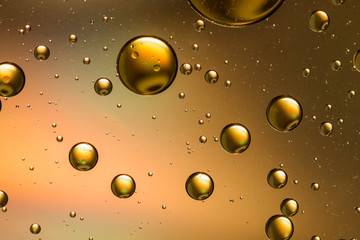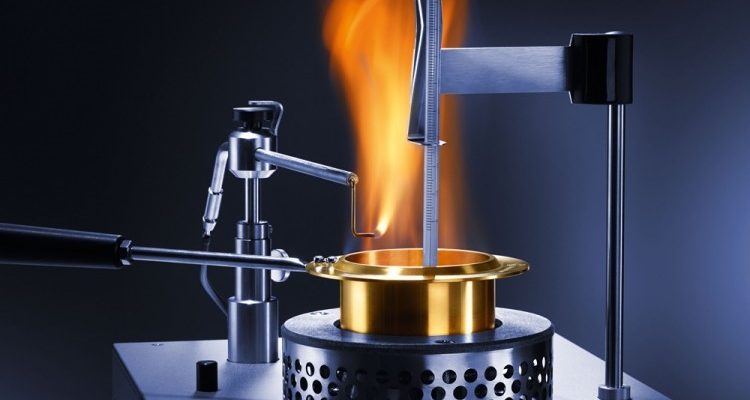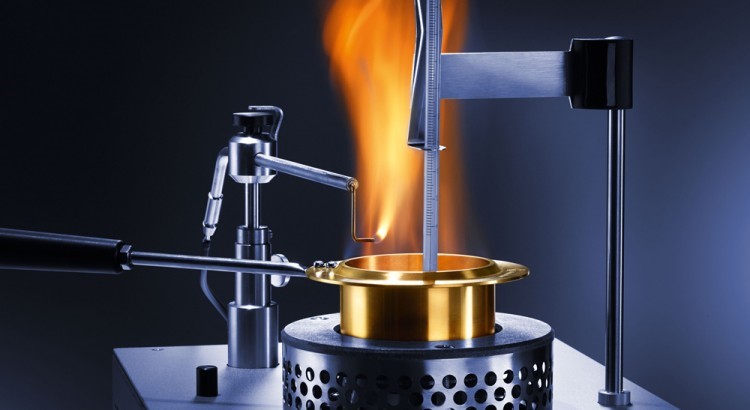Research has indicated that up to 60% of all engine failures are related to the engine cooling system and ultimately to the engine coolant being used. Despite this, many vehicle owners use the cheapest coolant available and at the lowest possible concentration.
While oil may be the lifeblood of a vehicle’s engine, no engine (bar the odd air-cooled engine still around) can operate effectively and reliably without a suitable coolant. To appreciate the significance of engine coolants we need to understand their functions in engine cooling systems:
- They need to be effective heat exchange fluids. The primary function of a coolant is to cool the engine by transferring heat away from internal engine surfaces to the cooling system.
- Coolants have to provide corrosion protection. They must protect all the materials in the cooling system from degradation due to interaction with the hostile environment present in the cooling system.
- They should protect against freezing (hence the name antifreeze). Water expands when it freezes which may well result in cracked engine blocks.
- Engine coolants must prevent boiling. Boiling can lead to overheating as a saturated boiling regime (steam) is very inefficient at transferring heat. Boiling will also cause additional (vapor phase) corrosion.
An ideal antifreeze engine coolant is a mixture of pure water and a high-quality coolant concentrate from a reputable supplier. The recommended concentration is 50% coolant concentrate and 50% water. Water is added since it is an effective heat transfer medium. A typical coolant concentrate is a blend of ethylene glycol, normally between 88% and 96%, and the balance is made up of rust and corrosion inhibitors, lubricity agents and foam inhibitors. Dyes are also added in minute quantities to indicate the presence of the concentrate in the cooling system. While these additives make up only a small fraction of the overall coolant, they are most instrumental in differentiating one coolant from another.
Traditional coolants (based on inorganic chemistry) provide protection against rust and corrosion by forming a protective layer of inhibitor salts on metal surfaces inside the engine that is in contact with the coolant (see Figure. 1 below). While this layer provides protection, it continuously consumes active ingredients (corrosion inhibitors) from the coolant to build and retain the protective layer. These inhibitors, once used, are no longer available to provide further protection. For this very reason, the maximum service interval for traditional coolant concentrates is two years when mixed with 50% water. Another disadvantage of traditional coolants is that the protective layer restricts the heat flow from the metal surfaces to the coolant.
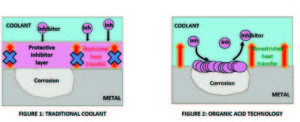
In contrast to traditional coolants, organic acid based coolants provide protection only where it is needed, i.e. where the corrosion actually takes place (Figure 2). As such it is targeted protection. It will effectively stop
corrosion from progressing, but at the same time corrosion inhibitor consumption is minimal and the majority of the surfaces in contact with the coolant remain unaffected. This results in:
- Unrestricted heat transfer across the metal/liquid interface.
- Longer coolant service life (hence the term long life coolant).
High quality engine coolants based on organic acid technology (OAT) may be used for periods up to five years when the concentrate is mixed 50/50 with water.
OAT long life engine coolants must not be mixed with traditional coolants since they incorporate different inhibitor chemistries. Not only will the two coolants dilute each other, they can also react chemically to form a gel rather than a liquid. The coolant then stops flowing through the system, clogs up coolant passages, water jackets, radiators, and heater cores. The water pump overheats and fails due to starvation of the lubricity agent in the coolant. Head gaskets blow, heads warp, and the engine suffers major damage. If mixing occurs, it is best to have the entire system flushed. This is the only way to be sure that the system is clean and not at risk. Failure to flush the system can, and often does, lead to engine failure and costly repairs.
Although the preferred dilution ratio for coolants (traditional and OAT) is 50% coolant concentrate and 50% water, they are sometimes used at lower treat rates of the concentrate. In such instances the service intervals mentioned above should be reduced accordingly. The coolant concentrate, however, should not be used at mixing ratios of less than 30%. At such low dosages the coolant will not provide adequate corrosion protection of the engine metal surfaces in contact with the coolant.
Hard water is a serious problem in many parts of southern Africa and reduces the performance of antifreeze coolants, traditional coolants in particular. The minerals found in hard water, react with the (inorganic) inhibitors to form calcium or magnesium phosphate, which leads to scale formation on hot engine surfaces. This can result in loss of heat transfer or corrosion under the scale. To assist vehicle and equipment operators with this problem, many coolant manufacturers market pre-diluted coolants mixed 50/50 with pure high quality water. This also ensures that the correct ratio of concentrate and water is always being used.
Antifreeze engine coolants can be dyed any colour, but traditional coolants are generally blue/green in colour. Long life coolants are usually dyed orange/red. However, the aftermarket is loaded with high and low-quality coolants of all colours of the rainbow. Colour is therefore not a good indicator of the type and quality of a coolant. Although many consumers use price as the deciding factor when purchasing antifreeze engine coolants, it should be remembered that you only get what you pay for. Some of the low-priced coolants available in the market are not much more than dyed water, contributing limited cooling system protection. The best maintenance practice is to know the exact coolant required for your vehicle or equipment, source it from a reputable supplier and use it at the concentration recommended by the engine manufacturer.
If you are in doubt our experts are at your disposal and ready to provide you with advice and answer any questions you may have.




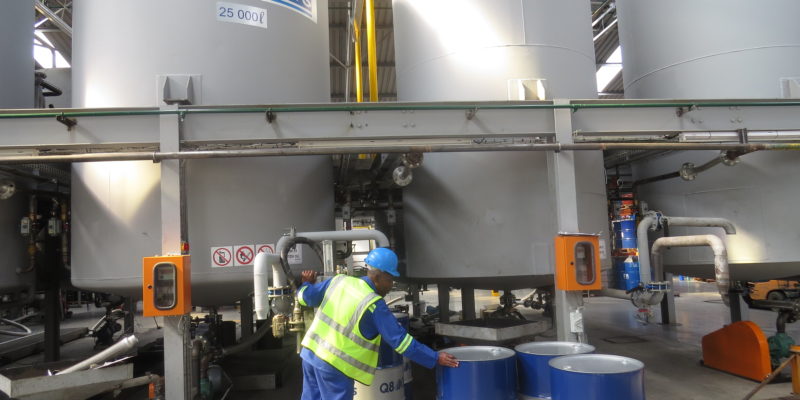
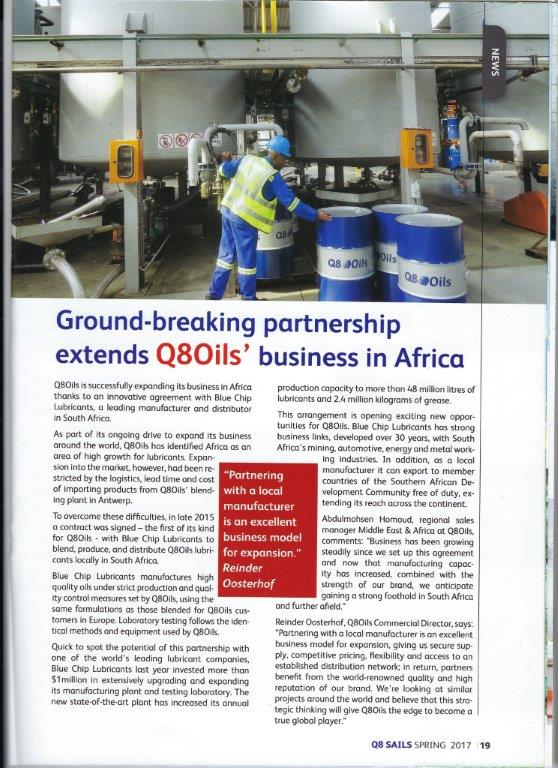
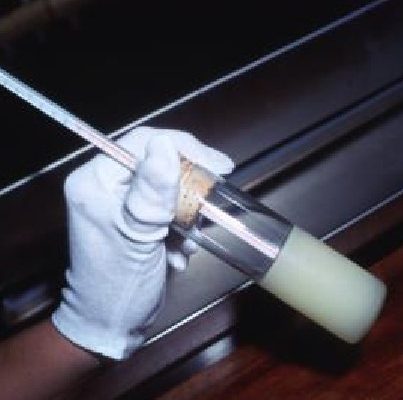

 To improve (reduce) the pour point of these oils, pour point depressants (PPDs) are added. PPDs do not in any way affect the temperature at which wax crystallizes or the amount of wax that precipitates. They simply ‘coat’ the wax crystals preventing them to interlock and forming three-dimensional structures that inhibit oil flow. Good PPDs can lower the pour point by as much as 40 0 C, depending on the molecular weight of the oil.
To improve (reduce) the pour point of these oils, pour point depressants (PPDs) are added. PPDs do not in any way affect the temperature at which wax crystallizes or the amount of wax that precipitates. They simply ‘coat’ the wax crystals preventing them to interlock and forming three-dimensional structures that inhibit oil flow. Good PPDs can lower the pour point by as much as 40 0 C, depending on the molecular weight of the oil.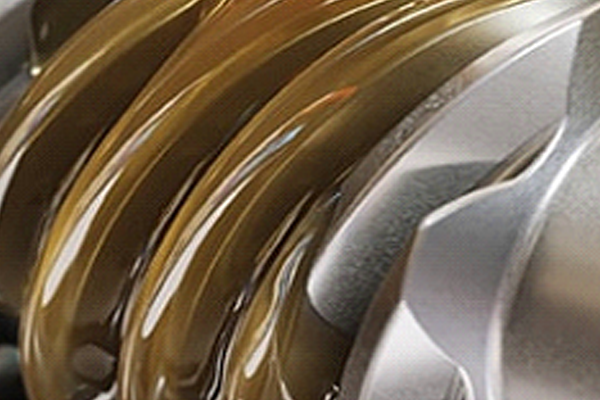
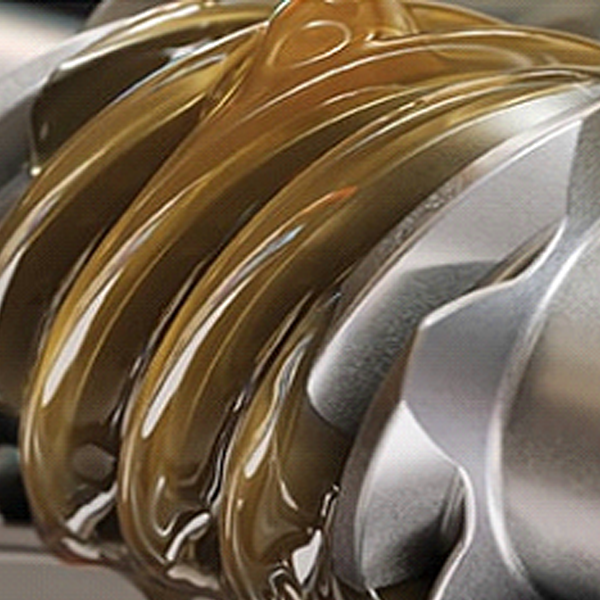
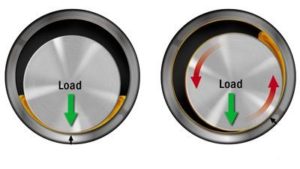 imes, we need to look at how friction and wear occur between moving machine surfaces. These surfaces appear smooth to the naked eye, but they are actually rough and uneven. Tiny peaks called asperities stick out and scrape against asperities on the opposing surface, causing friction and wear. The prime function of a lubricant is to prevent, or at least reduce, wear between surfaces moving on one another. We will endeavour to explain the lubrication of a plain journal bearing in parallel to the skiing analogy above. To enable the shaft to rotate in the bearing on the left, the diameter of the shaft must be less than the inside diameter of the bearing. This creates a wedge similar to the one between the skis and the water.
imes, we need to look at how friction and wear occur between moving machine surfaces. These surfaces appear smooth to the naked eye, but they are actually rough and uneven. Tiny peaks called asperities stick out and scrape against asperities on the opposing surface, causing friction and wear. The prime function of a lubricant is to prevent, or at least reduce, wear between surfaces moving on one another. We will endeavour to explain the lubrication of a plain journal bearing in parallel to the skiing analogy above. To enable the shaft to rotate in the bearing on the left, the diameter of the shaft must be less than the inside diameter of the bearing. This creates a wedge similar to the one between the skis and the water. he shaft and bearing asperities in a lubricated system will be in physical contact. The major portion of wear in any machine takes place in this regime. To prevent excessive wear within this regime, lubricants are formulated with additives to form a low-friction, protective layer on the wear surfaces. The base oil of the lubricant acts as a carrier to deposit the additives where they are needed. A suitable viscosity is important to ensure the oil can flow into tight spaces to lubricate the surfaces. The additive chemistry (anti-wear or extreme pressure) used within the lubricant is determined by the application.
he shaft and bearing asperities in a lubricated system will be in physical contact. The major portion of wear in any machine takes place in this regime. To prevent excessive wear within this regime, lubricants are formulated with additives to form a low-friction, protective layer on the wear surfaces. The base oil of the lubricant acts as a carrier to deposit the additives where they are needed. A suitable viscosity is important to ensure the oil can flow into tight spaces to lubricate the surfaces. The additive chemistry (anti-wear or extreme pressure) used within the lubricant is determined by the application.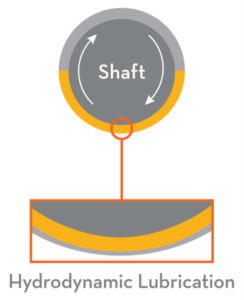
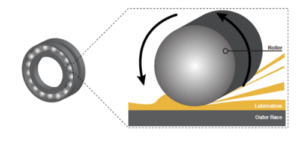 the pressure that develops is sufficient to separate the roller and raceway completely. In fact, the pressure is high enough for the surfaces to deform elastically. The deformation only occurs in the contact zone, and the metal elastically returns to its normal form as the rotation continues, hence the term elastohydrodynamic lubrication. This lubrication regime may be compared to a car tyre aquaplaning on water. It occurs when water on the road accumulates in front of the tyre faster than the weight of the car can push push it out of the way.
the pressure that develops is sufficient to separate the roller and raceway completely. In fact, the pressure is high enough for the surfaces to deform elastically. The deformation only occurs in the contact zone, and the metal elastically returns to its normal form as the rotation continues, hence the term elastohydrodynamic lubrication. This lubrication regime may be compared to a car tyre aquaplaning on water. It occurs when water on the road accumulates in front of the tyre faster than the weight of the car can push push it out of the way.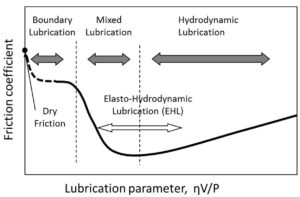

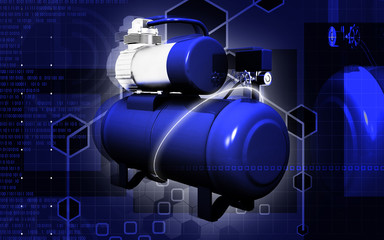
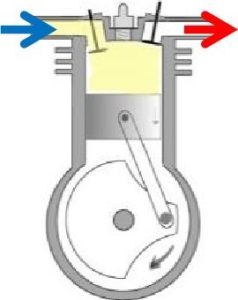 Reciprocating compressors function similarly to a car engine. A piston slides back and forth in a cylinder, which draws in and compresses the air, and then discharges it at a higher pressure. Reciprocating compressors are frequently multiple-stage systems, which means that one cylinder’s discharge will lead into the input side of the next cylinder. This allows for more compression than a single stage. Due to their relatively low cost, reciprocating compressors are probably the most commonly used compressors.
Reciprocating compressors function similarly to a car engine. A piston slides back and forth in a cylinder, which draws in and compresses the air, and then discharges it at a higher pressure. Reciprocating compressors are frequently multiple-stage systems, which means that one cylinder’s discharge will lead into the input side of the next cylinder. This allows for more compression than a single stage. Due to their relatively low cost, reciprocating compressors are probably the most commonly used compressors.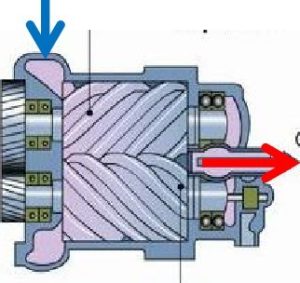 These compressors use two meshing screws (also called rotors) to compress the air. In oil flooded rotary screw compressors, lubricating oil bridges the space between the rotors. This provides a hydraulic seal and transfers mechanical energy between the driving rotor and the driven rotor. Air enters at the suction side, the meshing rotors force it through the compressor, and the compressed air exits at the end of the screws.
These compressors use two meshing screws (also called rotors) to compress the air. In oil flooded rotary screw compressors, lubricating oil bridges the space between the rotors. This provides a hydraulic seal and transfers mechanical energy between the driving rotor and the driven rotor. Air enters at the suction side, the meshing rotors force it through the compressor, and the compressed air exits at the end of the screws.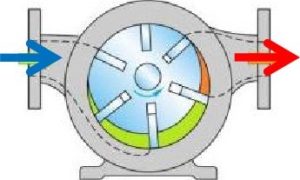 Rotary vane compressors consist of a rotor with a number of blades (vanes) inserted in radial slots in the rotor. The rotor is mounted offset in a housing. As the rotor turns, the blades slide in and out of the slots, keeping contact with the wall of the housing. Thus, a series of increasing and decreasing volumes are created by the rotating blades to compress the air. Centrifugal forces ensure that the vanes are always in close contact with the housing to form an effective seal.
Rotary vane compressors consist of a rotor with a number of blades (vanes) inserted in radial slots in the rotor. The rotor is mounted offset in a housing. As the rotor turns, the blades slide in and out of the slots, keeping contact with the wall of the housing. Thus, a series of increasing and decreasing volumes are created by the rotating blades to compress the air. Centrifugal forces ensure that the vanes are always in close contact with the housing to form an effective seal. A rotating impeller in a shaped housing is used to force the air to the rim of the impeller, increasing the velocity of the air. A diffuser (divergent duct) section converts the velocity energy to pressure energy. Radial compressors are primarily used to compress air and gasses in stationary industrial applications.
A rotating impeller in a shaped housing is used to force the air to the rim of the impeller, increasing the velocity of the air. A diffuser (divergent duct) section converts the velocity energy to pressure energy. Radial compressors are primarily used to compress air and gasses in stationary industrial applications. These compressors use fanlike airfoils (also known as blades or vanes) to compress air or gas. The airfoils are set in rows, usually as pairs, one rotating and one stationary. The rotating airfoils (rotors) accelerate the air. The stationary airfoils (stators) redirect the flow direction, preparing it for the rotor blades of the next stage. Axial compressors are normally used where very high flow rates are required. By nature of their design, axial flow compressors are almost always multi-stage.
These compressors use fanlike airfoils (also known as blades or vanes) to compress air or gas. The airfoils are set in rows, usually as pairs, one rotating and one stationary. The rotating airfoils (rotors) accelerate the air. The stationary airfoils (stators) redirect the flow direction, preparing it for the rotor blades of the next stage. Axial compressors are normally used where very high flow rates are required. By nature of their design, axial flow compressors are almost always multi-stage.